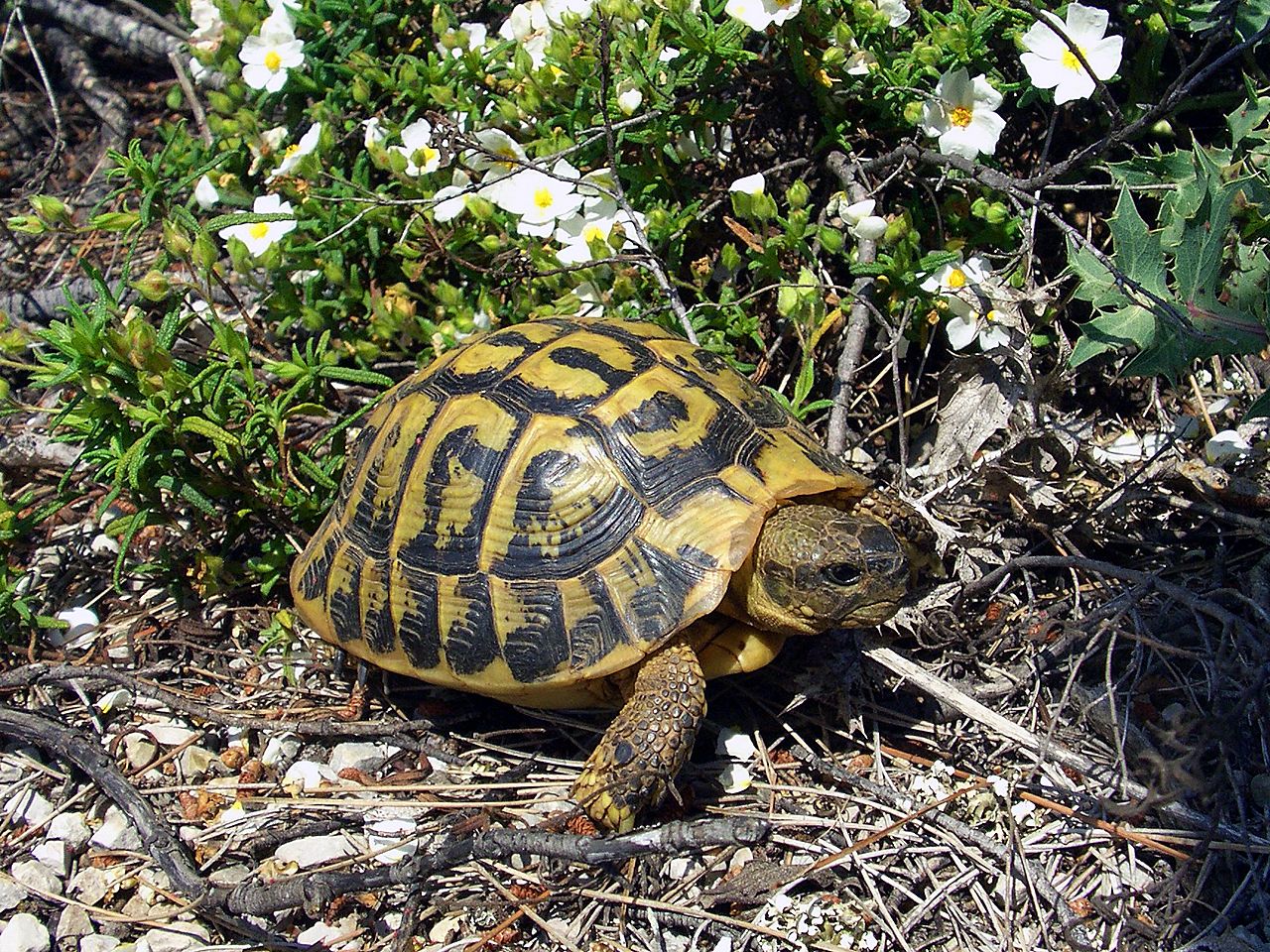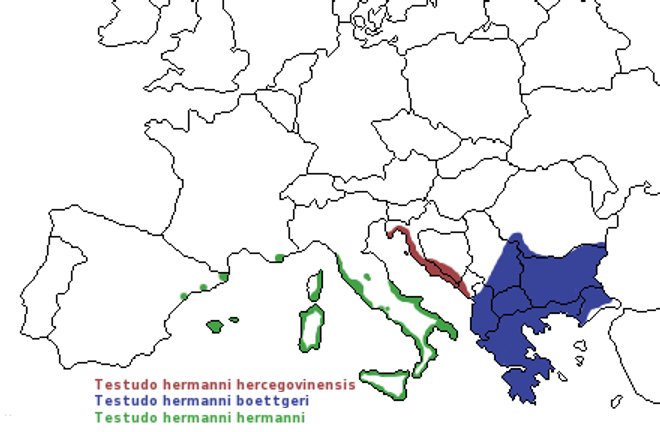- Hermann's Tortoise
Taxobox
name = Hermann's Tortoise

image_width = 240px
image_caption = "Testudo hermanni hermanni" onMajorca
status = LR/nt
status_system = iucn2.3
regnum =Animal ia
phylum =Chordata
classis =Sauropsida
ordo =Testudines
subordo =Cryptodira
familia =Testudinidae
genus = "Testudo" (disputed)
species = "T. hermanni"
binomial = "Testudo hermanni"
binomial_authority = Gmelin,1789
range_
range_map_width = 240px
range_map_caption = Range map. Western green population is "hermanni", eastern blue "boettgeri" and red "hercegovinensis".
synonyms ="Testudo hercegovinensis"
and see textHermann's Tortoise ("Testudo hermanni") is one of five
tortoise species traditionally placed in thegenus "Testudo", which also includes the well-knownMarginated Tortoise ("T. marginata"),Greek Tortoise ("T. graeca"), andRussian Tortoise ("T. horsfieldii"), for example. Threesubspecies are known: the Western Hermann's Tortoise ("T. h. hermanni"), the Eastern Hermann's Tortoise ("T.h. boettgeri") and Dalmatian Tortoise ("T.h. hercegovinensis"). Sometimes mentionedsubspecies "T.h. peleponnesica" is not yet confirmed to be genetically different to "T.h. boettgeri"."Testudo hermanni" can be found throughout southern Europe. The western population ("hermanni") is found in eastern Spain, southern France, the Baleares islands, Corsica, Sardinia, Sicily, south and central Italy (Tuscany). The eastern population ("boettgeri") Kosovo, Macedonia, Romania, Bulgaria, Albania, and Greece. While "hercegovinensis" populates coasts of Bosnia and Herzegovina, Croatia and Montenegro.
Description and systematics
Hermann's tortoises are small to medium sized tortoises that come from southern Europe. Young animals, and some adults, have attractive black and yellow patterned carapaces, although the brightness may fade with age to a less distinct gray, straw or yellow coloration.
The eastern subspecies "Testudo hermanni boettgeri" is much larger than the western, reaching sizes up to 28 cm (11
inches ) in length. A specimen of this size may weigh 3-4 kg (6-9 lb). "T. h. hermanni" rarely grow larger than 18 cm (7.5 inches). Some adult specimens are as small as 7 cm (3 inches).In 2006 it was suggested to move Hermann's Tortoise to the genus "Eurotestudo" and to bring the subspecies to the rank of species ("Eurotestudo hermanni" and "Eurotestudo boettgeri") [de Lapparent de Broin (2006)] . Though there are some indications that this might be correct [e.g. Fritz "et al." (2005)] , the data at hand is not unequivocally in support and the relationships between Hermann's and the
Russian Tortoise among each other and to the other species placed in "Testudo" are not robustly determined. Hence it seems doubtful that the new genus will be accepted for the time being. The elevation of the subspecies to full species was tentatively rejected under the Biological Species Concept at least, as there still seems significantgene flow .Fritz "et al." (2006)]It was also noted that the rate of
evolution as measured bymutations accumulating in themtDNA differs markedly, with the eastern populations having evolved faster. This is apparently due to stronger fragmentation of the population on the mountainousBalkans during thelast ice age . While this has no profound implications fortaxonomy of this species - apart from suggesting that two other proposed subspecies are actually just local forms at present -, it renders the use ofmolecular clock s in "Testudo" even more dubious and unreliable than they are for turtles in general [Avise "et al." (1992), van der Kuyl "et al." (2005)] ."Testudo hermanni hermanni"
The subspecies "Testudo hermanni hermanni" includes the former subspecies "robertmertensi" and has a number of local forms. It has a highly arched shell with an intensive coloration, with its yellow coloration making a strong contrast to the dark patches. The colors wash out somewhat in older animals, but the intense yellow is often maintained. The underside has two connected black bands along the central seam.
The coloration of the head ranges from dark green to yellowish, with isolated dark patches. A particular characteristic is the yellow fleck on the cheek found in most specimens, although not in all; "robertmertensi" is the name of a morph with very prominent cheek spots. Generally, the forelegs have no black pigmentation on their undersides. The base of the claws is often lightly colored. The tail in males is larger than in females and possesses a spike. Generally the shell protecting the tail is divided. A few specimens can be found with undivided shells, similar to the Greek Tortoise.
"Testudo hermanni boettgeri"
The subspecies "hercegovinensis" (Balkans coast) and the local "peloponnesica" (SW
Peloponnesus coast) are now included here; they constitute local forms that are not yet geographically or in other ways reproductively isolated and apparently derive fromrelict populations of thelast ice age . The Eastern Hermann's Tortoise also has an arched, almost roundcarapace , but some are notably flatter and more oblong. The coloration is brownish with a yellow or greenish hue and with isolated black flecks. The coloring tends to wash out quite strongly in older animals. The underside is almost always solid horn color, and has separate black patches on either side of the central seam.The head is brown to black, with fine scales. The forelegs similarly possess fine scales. The limbs generally have five claws, which are darkly colored at their base. The hindlegs are noticeably thicker than the forelegs, almost plump. The particularly strong tail ends in a spike, which may be very large in older male specimens. Females have noticeably smaller tailspikes, which are slightly bent toward the body.
Ecology
Early in the morning, the animals leave their nightly shelters, which are usually hollows protected by thick bushes or hedges, to bask in the sun and warm their bodies. They then roam about the Mediterranean meadows of their habitat in search of food. They determine which plants to eat by the sense of smell. (In captivity, they are known to eat
dandelion s,clover andlettuce as well as the leaves, flowers, and pods of almost alllegume s.) In addition to leaves and flowers, the animals eat fruits as supplementary nutrition. They only eat a small amount of fruit, just enough to satisfy themselves.Around midday, the sun becomes too hot for the tortoises, so they return to their hiding places. They have a good sense of direction to enable them to return. Experiments have shown that they also possess a good sense of time, the position of the sun, the magnetic lines of the earth, and for landmarks. In the late afternoon, they leave their shelters again and return to feeding.
Tortoises are particularly long-lived animals, which are presumed to live as long as 70-100 years.
In captivity
anctuaries
There are several tortoise sanctuaries in Europe such as "Carapax" in southern Tuscany, and "Le Village Des Tortues" in the South of France (near Gonfaron). These sanctuaries rescue injured tortoises whilst also taking in unwanted pets. These two sanctuaries specialise in Hermann's tortoises.
Outdoors
In order to keep Hermann's tortoise in a temperate climate, the pen must be placed in a very sunny location. The most important part of the pen is a tortoise house that they can use as a shelter. This should be a weatherproof box with an openable roof and an entry way for the animals. The floor should consist of soil as in the wild to enable burying and thermoregulation.Their life pattern in captivity is the same as in the wild. They leave the house in the early morning to warm themselves and then begin to eat. They should be provided with a wide range of edible materials. They eat for about an hour before returning to the house. In the late afternoon, they come out again for a second meal. They can be kept outdoors approximately from mid-March to the end of October. The pen should normally be constructed from natural stones.
The tortoise house must be relatively large, some 0.4 m³ (14 ft³) in size. It should be made of wood and have no floor to enable the tortoise to thermoregulate its own body temperature via burying itself. Other materials will produce a house that is too hot or too cold. There should be a heat lamp operated by thermostatic control
Indoors
Hatchlings and young specimens can be kept indoors, and although a vivarium is often offered as suitable accommodation, the humidity in such an enclosure can reach levels much higher than commonly found in the wild, leading to respiratory problems. A clamp lamp should be fastened to it so that a 40 to 60-watt reflector bulb is some 20 cm (8 in) above the level of the gravel of the enclosure. The bulb is turned on in the morning so that the animals can bask and then feed, a source of UV must also be provided, in the form of a HighUV fluorescent tube, or similar. The animals should also regularly be put into sunlight in the summer outdoors to provide them with necessary ultraviolet radiation, placing a tortoise on a window sill in winter will not provide the required level of UV, as glass will filter out UV.
The animals must be allowed to self regulate their temperature. This can be achieved by providing a temperature gradient in the enclosure, ranging from around 33 °C at the hot end to 18 °C at the cool end. The animal will then choose a position in the enclosure to reach its desired temperature
Hibernation
In nature, the animals dig their nightly shelters out and spend the relatively mild Mediterranean winters there. During this time, the heart rate and breathing rate drop notably. Domestic animals can be kept in the basement in a roomy rodent-proof box with a thick layer of dry leaves. The temperature should be around 5 degrees C As an alternative, the box can be stored in a refrigerator. For this method to be used, the fridge should be in regular day to day use, to permit air flow. During hibernation, it is vital that the ambient temperature not fall below zero. Full-grown specimens may sleep 4–5 months at a time.
Hatching Hermann's Tortoise
Footnotes
References
* (1992): Mitochondrial DNA evolution at a turtle's pace: evidence for low genetic variability and reduced microevolutionary rate in the Testudines. "Mol. Biol. Evol." 9(3): 457-473. [http://mbe.oxfordjournals.org/cgi/reprint/9/3/457.pdf PDF fulltext]
* (2006): "Eurotestudo", a new genus for the species "Testudo hermanni" Gmelin, 1789 (Chelonii, Testudinidae). [English with French abstract] "C. R. Palevol" 5(6): 803-811. doi|10.1016/j.crpv.2006.03.002 [http://www.landskildpadde.dk/Lapparent%20de%20Broin%20et%20al_2006_Eurotestudo_for_Testudo%20hermanni.pdf PDF fulltext]
* (2005): Environmentally caused dwarfism or a valid species - Is "Testudo weissingeri" Bour, 1996 a distinct evolutionary lineage? New evidence from mitochondrial and nuclear genomic markers. "Mol. Phylogenet. Evol." 37(2): 389–401. doi|10.1016/j.ympev.2005.03.007 [http://www.uni-heidelberg.de/institute/fak14/ipmb/phazb/pubwink/2005/07.2005.pdf PDF fulltext]
* (2006): A rangewide phylogeography of Hermann's tortoise, "Testudo hermanni" (Reptilia: Testudines: Testudinidae): implications for taxonomy. "Zool. Scripta" 35(5): 531-548. doi|10.1111/j.1463-6409.2006.00242.x [http://www.uni-heidelberg.de/institute/fak14/ipmb/phazb/pubwink/2006/04.2006.pdf PDF fulltext]
*|year=1996|id=21648|title=Testudo hermanni|downloaded=09 May 2006
* (2005): Mitochondrial haplotype diversity in the tortoise species "Testudo graeca" from North Africa and the Middle East. "BMC Evol. Biol." 5: 29. doi|10.1186/1471-2148-5-29 (HTML/PDF fulltext + supplementary material)
*cite news |first=Jon |last=Henley |authorlink= |coauthors= |title=Rare tortoise puts brakes on high-speed train link |url=http://www.guardian.co.uk/environment/2005/dec/09/france.conservationandendangeredspecies |work=The Guardian |publisher= |date=December 9, 2005 |accessdate=2008-07-22External links
* [http://www.mayer-richard.de/ Characteristics of European Tortoises (in German)]
* [http://www.petzoo.co.uk/product_info.php?products_id=405 Ideal Hermann's Tortoise Indoor Habitat]
Wikimedia Foundation. 2010.
